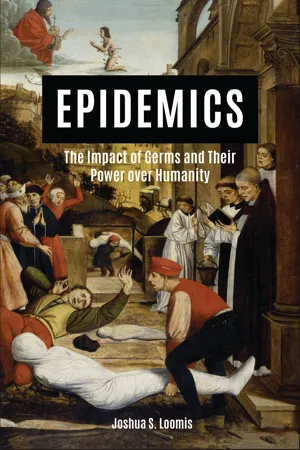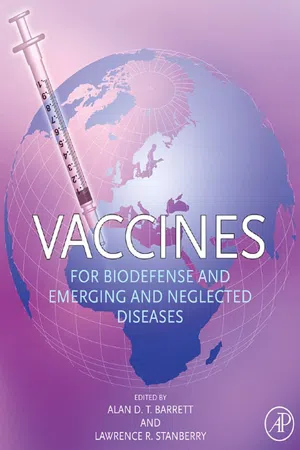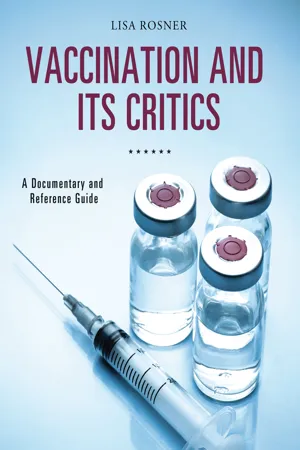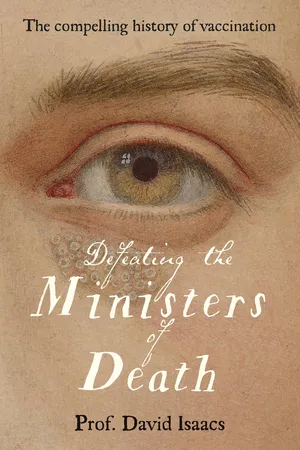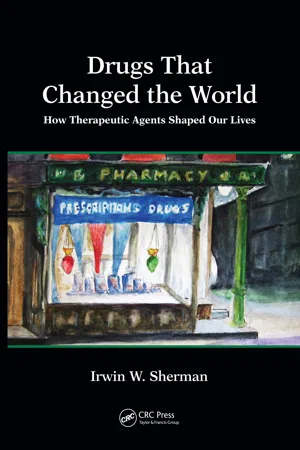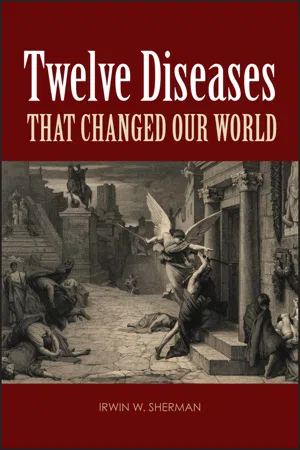Biological Sciences
Smallpox and Measles
Smallpox and measles are highly contagious viral diseases that have historically caused significant morbidity and mortality. Smallpox, caused by the variola virus, was declared eradicated in 1980 due to a successful global vaccination campaign. Measles, caused by the measles virus, remains a concern, particularly in areas with low vaccination rates, and can lead to severe complications.
Written by Perlego with AI-assistance
Related key terms
10 Key excerpts on "Smallpox and Measles"
- eBook - ePub
A History of Epidemics in Britain, Volume 2 (of 2)
From the Extinction of Plague to the Present Time
- Charles Creighton(Author)
- 2013(Publication Date)
- Perlego(Publisher)
variolae is in like manner translated “measles” on every occasion. In the English dictionary by Baret, belonging to the same period, measles is defined as “a disease with many reddish spottes or speckles in the face and bodie, much like freckles in colour”—which seems to exclude the possibility of a pustular disease having been part of the Elizabethan notion of measles.Notwithstanding this singular usage of the vocabularies and dictionaries, the name of smallpox occurs by itself in letters or other memorials of the Elizabethan period, having been doubtless correctly applied to the true pustular variola. In the short essay on smallpox by Kellwaye, appended to his book on the plague (1593), measles and smallpox are distinguished on the whole clearly, according to the definitions of Fracastori or other foreign writers of the 16th century. The association between measles and smallpox that survived longest was a peculiar and somewhat uncommon one; certain cases of smallpox, in which the pustules were wholly or partially represented by, or changed into, broad spots level with the skin, red or livid in colour, and in which haemorrhages occurred from the nose, lungs, bowels or kidneys, that is to say, cases of haemorrhagic smallpox, were apt to be called, from the time of James I. until as late as the case of Queen Mary in 1694, by the name of “Smallpox and Measles mingled.”From the date of the annual bills of mortality by the Parish Clerks of London, the year 1629, it is improbable that there was any real confusion between Smallpox and Measles; there was certainly some ambiguity in the entry of measles long after, but that later confusion, especially in the second half of the 18th century, was with scarlatina[1184] - eBook - ePub
Epidemics
The Impact of Germs and Their Power over Humanity
- Joshua S. Loomis(Author)
- 2018(Publication Date)
- Praeger(Publisher)
2 The disease was especially devastating for children younger than the age of five, having mortality rates that approached 95 percent in some places. It was so bad that parents would commonly wait to name their children until after they had survived smallpox. Furthermore, unlike plague, which quickly killed a large number of people and then gradually disappeared over time, smallpox tended to decimate a population during its first exposure and then remain there permanently as an endemic disease, steadily killing about 30 percent of those newly infected, year in and year out. Over time, it would become so common in the population that nearly every person would be exposed to it at some point in their lifetime. This pattern continued from ancient times until the mid-20th century, when a worldwide vaccination effort led to arguably one of the greatest achievements in our history—the total eradication of smallpox from humankind. Smallpox no longer exists in nature, and so for the remainder of this chapter, it will be referred to in the past tense.The vast majority of smallpox cases (more than 90%) were due to infection with the highly contagious variola major virus while a smaller number of less severe smallpox cases were caused by variola minor. These viruses were most commonly spread between humans through the direct inhalation of contaminated respiratory secretions and less frequently through skin exposure to contaminated body fluids or inanimate objects. There is some evidence that in rare cases it could also be acquired through eye exposure to infected fluids or spread across the placenta from an infected mother to her fetus. Importantly, human variola viruses were never found in any animal vectors nor were they present in the water or soil. Thus smallpox could only be acquired from another infected person.Once inside the body, variola viruses were internalized by local immune cells called macrophages and moved to the closest lymph nodes. The viruses would then replicate there slowly at first, moving methodically from cell to cell, and then cause a large-scale explosion of infected cells approximately 6–10 days postinfection. This release of virus into the bloodstream, called viremia, allowed the virus to gain access to other tissues and organs. During this time, infected persons would exhibit flu-like symptoms, fever, muscle aches, nausea, and characteristic rashes of the skin and eyes. Most people developed large pustules, predominantly on their face and extremities, whereas others developed a flat, hemorrhagic rash. Further replication and spread of the virus often caused internal hemorrhaging, pneumonia, shock, and death by 16 days postinfection. Since variola - Alan D.T. Barrett, Lawrence R. Stanberry(Authors)
- 2009(Publication Date)
- Academic Press(Publisher)
Fenner, 1988 ).Historical accounts indicate that there were two separate epidemiological patterns to the disease. When smallpox was introduced into a naive population it spread rapidly, infecting nearly every susceptible individual. These outbreaks affected all age groups and had very high mortality rates. The introduction of the disease to the Native Americans and Australian aborigines are the best documented examples of smallpox’s destructive power, however there is no reason to believe that it was any less deadly among the naive populations in China, India, or Europe hundreds or thousands of years earlier.In geographical areas with endemic smallpox the disease continually circulated through the community with seasonal outbreaks mostly in winter and spring when conditions (i.e., temperature and humidity) allowed the virus to persist longer in the environment. These larger outbreaks would occur when sufficient numbers of uninfected people accumulated in a town or city to allow a full-fledged epidemic. Most of the adults in the affected region were survivors of previous attacks and were immune to the disease, consequently disease outbreaks in these areas primarily affected children.Smallpox as a Biological Weapon
Smallpox has a long history of use as a biological weapon, with most of the documented incidents coming from the Western Hemisphere (Hopkins, 1983 ; Bhalla and Warheit, 2004 ; Frischknecht, 2003 ) (Table 37.3 ). After the eradication it was thought that the likelihood of smallpox being intentionally reintroduced as a biological weapon was remote. That viewpoint changed in the 21st century (Henderson et al., 1999 ) after details came to light about the extensive nature of the Soviet and Iraqi biological weapons programs (Alibek, 2004 ; Roffey et al., 2002 ). The anthrax attacks in the US in 2001, as well as the large number of conventional terrorist attacks shortly thereafter were grim reminders that individuals and groups were willing to use such weapons. The CDC created a categorized list of potential biological agents with variola listed as one of the most likely pathogens to be used as a biological weapon (Henderson et al., 1999 ; Bhalla and Warheit, 2004 ). Smallpox has several key features which make it an excellent choice for a biological weapon (Fig. 37.6 ) (Tegnell et al., 2002 ; Blendon et al., 2003 ; Mahy, 2003 ; Pennington, 2003 ; Whitley, 2003 ; Cleri et al., 2006- eBook - ePub
Vaccination and Its Critics
A Documentary and Reference Guide
- Lisa Rosner(Author)
- 2017(Publication Date)
- Greenwood(Publisher)
2
NATURE’S WAY AND THE BEGINNING OF IMMUNIZATION (1500s–1790s)
SMALLPOX AS CHILDHOOD DISEASE
- Document: Abu Bakr Muhammad Ibn Zakariya al-Razi, known as Rhazes, A Treatise on the Smallpox and Measles
- Date: ca. 900 CE
- Where: Baghdad, Persia
- Significance: al-Razi was the first to provide a clinical examination of Smallpox and Measles and to differentiate between them. He was also the first to note that survivors of smallpox develop immunity to the disease.
DOCUMENT
AUTHOR’S PREFACE In the name of GOD, the Compassionate, the Merciful.It happened on a certain night at a meeting in the house of a nobleman, of great goodness and excellence, and very anxious for the explanation and facilitating of useful sciences for the good of mankind, that, mention having been made of the Small-Pox, I then spoke what came into my mind on that subject. Whereupon our host (may GOD favour men by prolonging the remainder of his life) wished me to compose a suitable, solid, and complete discourse on this disease, because there has not appeared up to this present time either among the ancients or the moderns an accurate and satisfactory account of it. And therefore I composed this discourse, hoping to receive my reward from the Almighty and Glorious GOD, and awaiting His good pleasure.On the symptoms which indicate the approaching eruption of the Small-Pox and Measles
The eruption of the Small-Pox is preceded by a continued fever, pain in the back, itching in the nose, and terrors in sleep. These are the more peculiar symptoms of its approach, especially a pain in the back, with fever; then also a pricking which the patient feels all over his body; a fullness of the face, which at times goes and comes; an inflamed colour, and vehement redness in both the cheeks; a redness of both the eyes; a heaviness of the whole body; great uneasiness, the symptoms of which are stretching and yawning; a pain in the throat and chest, with a slight difficulty in breathing, and cough; a dryness of the mouth, thick spittle, and hoarseness of the voice; pain and heaviness of the head; inquietude, distress of mind, nausea, and anxiety; (with this difference, that the inquietude, nausea, and anxiety are more frequent in the Measles than in the Small-Pox; while, on the other hand, the pain in the back is more peculiar to the Small-Pox than to the Measles;) heat of the whole body, an inflamed colour, and shining redness, and especially an intense redness of the gums. - eBook - ePub
- George Henry Fox(Author)
- 2015(Publication Date)
- Perlego(Publisher)
Typhoid and Typhus.—Typhoid and typhus fevers have at times been confounded with smallpox. But errors of this kind can be made only where the history of the case is completely ignored. In typhus, it is true, the eruption, petechial and almost papular in character, may suggest hemorrhagic smallpox; but the eruption of typhus rarely appears before the fourth or fifth day of the illness and is located chiefly on the trunk, sparing the face. The rash of malignant smallpox develops usually on the third or even the second day of the illness and is not limited to the trunk.Upon the appearance of the rash in a typical case of smallpox the febrile diseases with which it is most frequently confounded are measles and varicella. It is interesting to note that until the time of Sydenham, in the latter part of the seventeenth century, measles and smallpox were regarded as manifestations of the same disease, and that the Vienna school of dermatologists, even to this day, insists on the etiological unity of variola and varicella.Measles.—As a matter of fact the early papular eruption of measles bears a considerable resemblance to the first stage of the eruption of smallpox. In both the eruption is noted first in the face. In smallpox, however, the papules have a firm, “shotty” feeling on palpation, while in measles they are smooth and velvety to the touch. In measles the eruption, viewed at a little distance, seems to present a distinctly corymbose or crescentic grouping, an arrangement which is absent in smallpox. The eruption of smallpox appears at the end of the third day, that of measles on the fourth day. The temperature in smallpox undergoes a rapid defervescence upon the appearance of the rash, while in measles it continues to rise after the eruption appears. The pronounced pain in the back is absent in measles, while the very marked catarrhal symptoms, coryza, conjunctivitis, etc., are lacking in smallpox. The subsequent course of the eruption will leave no room for doubt, since within twenty-four hours the papules of smallpox will have developed into characteristic vesicles.Varicella. - eBook - ePub
- David Isaacs(Author)
- 2019(Publication Date)
- HarperCollins(Publisher)
CHAPTER 2 Smallpox, the speckled monsterThe story of smallpox, one of the first diseases to be recognised by humans, is remarkable in many ways. It includes war crimes, tragedy and triumph. The introduction of smallpox devastated whole populations in Central and South America and in Australia. When it did not kill, smallpox often left a terrible legacy of facial scarring and blindness. Smallpox continued to kill millions of people every year until a half-century ago: a mere drop in the ocean of time. Within a few short years, smallpox was defeated and disappeared. The global eradication of the scourge that was smallpox is one of the greatest ever achievements of medicine, a triumph of science and public health policy.Historical claims about smallpox are difficult to verify. Although the clinical features of the disease are reasonably characteristic, there are other infections that can mimic it, including chickenpox. Thus, although it is often claimed that Egyptian mummies had facial lesions resembling smallpox – including the mummy of Ramses V, who died in 1157 BC – it is by no means certain that Ramses really had smallpox, or that it killed him.There are descriptions of a disease with all the characteristics of smallpox in the ancient Indian medical texts Charaka Samhita and Sushruta Samhita, which were compiled in the first century BC at the latest. The first reliable description of smallpox was in China in the fourth century AD, although there is historical evidence to suggest the disease may have been imported to China as early as the third century BC.The horror of smallpox was that it spread through a community like wildfire, causing devastating disease. A healthy child or young adult suddenly developed severe headache, back pain, fever, nausea and vomiting, and rapidly became so weak they could hardly move. After two or three days, small red spots appeared on their face and spread rapidly to the rest of the body. The spots became enlarged, raised and blistered. Then the unfortunate victim usually died within days. People who survived were often left permanently disfigured by deep facial scars. No wonder smallpox was called ‘the speckled monster’. It could also cause corneal ulceration, which rendered up to a third of all survivors totally blind. - eBook - ePub
Drugs That Changed the World
How Therapeutic Agents Shaped Our Lives
- Irwin W. Sherman(Author)
- 2016(Publication Date)
- CRC Press(Publisher)
Chapter 6Smallpox and Vaccination
A child with smallpox. (Courtesy of the CDC Public Health Image Library.)A Look Back The Disease Smallpox “Catching” Smallpox Variolation Vaccination The Social Context of Smallpox VaccinationSmallpox is no longer with us, but over the centuries, it killed hundreds of million people. In the twentieth century alone, it killed 300 million people—three times the number of deaths from all the twentieth-century wars. Smallpox has been involved with war, with exploration, and with migration. As a result, it changed the course of human history. Smallpox was indiscriminate, with no respect for social class, occupation, or age; it killed or disfigured princes and paupers, kings and queens, children and adults, farmers and city dwellers, generals and their enemies, and rich and poor.A Look Back
At one time, smallpox was one of the most devastating of all human diseases, yet no one really knows when smallpox began to infect humans. It is suspected that humans acquired the infectious agent from one of the pox-like diseases of domesticated animals, in the earliest concentrated agricultural settlements of Asia or Africa, when humans began to maintain herds of livestock, sometime after 10,000 BC. The best evidence of smallpox in humans is found in three Egyptian mummies, dating from 1570 to 1085 BC, one of which is Pharaoh Ramses V, who died as a young man in 1155 BC. The mummified face, neck, and shoulders of the Pharaoh bear the telltale scars of the disease: pockmarks. (The word pox comes from the Anglo-Saxon word “pocca,” meaning pocket or pouch and describes the smallpox fingerprint—craterlike scars.)From its origins in the dense agricultural valleys of the great rivers in Africa and India, smallpox spread from the West to China, first appearing about 200 BC. Trade caravans assisted in the spread of smallpox, but at the time of the birth of Christ, it was probably not established in Europe because the populations were too small and greatly dispersed. Smallpox was unknown in Greece and Rome and was not a major health threat until about 100 AD, when there was a catastrophic epidemic called the Plague of Antoninus. The epidemic started in Mesopotamia, and the returning soldiers brought it home to Italy. It raged for 15 years, and there were 2000 deaths daily in Rome. - eBook - ePub
- Irwin W. Sherman(Author)
- 2007(Publication Date)
- ASM Press(Publisher)
The cause of smallpox is a virus, one of the largest of the viruses; with proper illumination it can actually be seen under a light microscope. However, much of its detailed structure can be visualized only by using the electron microscope. The outer surface (capsid) of the smallpox virus resembles the facets of a diamond, and its inner, dumbbell-shaped core contains the genetic material, double-stranded DNA. The virus has about 200 genes, 35 of which are thought to be involved in virulence.Most commonly the smallpox virus enters the body through droplet infection by inhalation. However, it can be transmitted by direct contact or through contaminated fomites (inanimate objects) such as clothing, bedding, blankets, and dust. The infectious material from the pustules can remain infectious for months. The virus multiplies in the mucous membranes of the mouth and nose. During the first week of infection there is no sign of illness; however, the virus can be spread by coughing or by nasal mucus at this time. The virus moves on to the lymph nodes and then to the internal organs via the bloodstream. Once there, it multiplies again. It then reenters the bloodstream. Around the ninth day the first symptoms appear: headache, fever, chills, nausea, muscle ache, and sometimes convulsions. The person feels quite ill. A few days later a characteristic rash appears. The individual is infectious a day before the rash appears and until all the scabs have fallen off. Many infected persons die a few days or a week after the rash appears. Destruction of the sebaceous (oil) glands of the skin leaves permanent craterlike scars in the skin, known as pockmarks.There are two varieties of the smallpox (variola) virus: major and minor. They can be distinguished by differences in their genes. Variola major, the deadlier form, frequently killed up to 25% of its victims, although in naïve populations such as the Amerindians the fatality rate could exceed 50%. Variola minor, - eBook - ePub
- Ethne Barnes(Author)
- 2007(Publication Date)
- University of New Mexico Press(Publisher)
13: Memories of SmallpoxThe World Health Organization officially declared smallpox eradicated in May 1980. This declaration followed the last known naturally acquired case, identified in Somalia, in east Africa, in October 1977 (Benenson 1981b). WHO closed the book on smallpox through extensive vaccination campaigns and intense epidemiological controls from 1967 to 1977. Since smallpox was no longer considered a threat to humanity, vaccinations against the disease then ceased.By 1966 the last major endemic areas of smallpox had localized primarily in Western Asia. Countries involved included Bangladesh, India, Nepal, Pakistan, and Afghanistan. Other endemic foci existed in parts of Africa and in Indonesia. By 1976 the last remaining battleground for control of the disease had been confined to rural areas of Ethiopia and Somalia (Hopkins 1983).The last major outbreak in Europe occurred in the Balkans in 1972, where it was brought in by Muslim pilgrims returning from Mecca (Hopkins 1983). The disease had disappeared from the United States by 1949, and the last known case of smallpox in the Americas occurred in 1971 in Brazil (Benenson 1981b; Cockerell 1997).The Virus
Smallpox is caused by a virus known as variola, one of many pox viruses that have been infecting a large range of animal species throughout the world for millennia. They represent the largest and most complex of the pathogenic viruses, having a brick-shaped or elliptical classic form consisting of two strands of DNA. Unlike most DNA viruses that replicate within the nucleus of the host cell, pox viruses manage to replicate outside the nucleus within the cytoplasm of the infected cell. The virus sheds its double membranous coat once it gains entry into the host cell, and slowly begins absorbing from the cytoplasm selected nutrients needed for its replication. Replicated forms of the virus appear either as minute masses or as thread-like strands scattered throughout the cytoplasm of the infected cell. Replicating variola viral clusters often enclose any adjacent material, including other viruses such as Herpes simplex - eBook - ePub
Agents of Bioterrorism
Pathogens and Their Weaponization
- Geoffrey Zubay(Author)
- 2008(Publication Date)
- Columbia University Press(Publisher)
CHAPTER 11 SMALLPOX (VARIOLA VIRUS) Rohit Puskoor and Geoffrey ZubayP rior to the mid-twentieth century, smallpox was one of the most dreaded diseases. Even if you recovered, your face and body were covered with pockmarks for the rest of your life. It was extremely infectious from one human to another and one of the most lethal diseases in circulation. Vaccines were first introduced against smallpox, and they were enormously effective almost from the very beginning. Vaccinia virus is currently used to make vaccine against variola virus, the virus that causes human smallpox. Except in very rare cases, the vaccinia-derived vaccine has no adverse reactions in humans. Because poxviruses tend to be very host-specific, there is no smallpox reservoir other than what exists in human hosts. Realizing this, immunologists organized a worldwide organization with the intention of completely eradicating smallpox. All they needed was a very large supply of effective vaccine and many field workers.HISTORYArea by area, smallpox was eliminated. If a case of smallpox was spotted, every effort was made to isolate the victim and vaccinate everyone who might have come into contact with him or her. By 1977 it appeared that smallpox had been eradicated worldwide, and no new cases have been reported since. The Soviet Union and the United States, however, held onto supplies of smallpox for military, defense, and research purposes. There is a fear that these stocks may have been pilfered and that there may be others—including terrorist groups—in possession of smallpox viruses. Because most people have not been vaccinated against smallpox for more than a quarter of a century, the possibility of uncontrolled possession makes smallpox an extremely serious threat, perhaps even more serious than it was when vaccination against smallpox was a common practice.Virtually unstoppable smallpox epidemics date back many thousands of years (table 11.1
Index pages curate the most relevant extracts from our library of academic textbooks. They’ve been created using an in-house natural language model (NLM), each adding context and meaning to key research topics.

